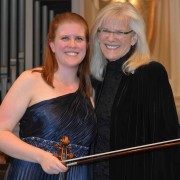Mozart and Brahms
Marlene’s Musings
November, 2013
At the age of 13, Mozart became concertmaster of the Salzburg court orchestra. Responsibilities for that position included conducting from the chair (Conductors, as they are today, were not a part of the orchestra) and performing as soloist. In 1775, between April and December, at age 19, Wolgang composed 4 violin concertos for that purpose.
We’ll be playing the 4th with Erin Keefe, new Concertmaster of the Minnesota Orchestra. Fiendishly difficult, it is the Mozart Concerto that violinists choose to show off.
The apparent ease with which Mozart created masterpieces was not a characteristic of Johannes Brahms but how could anyone follow in Beethoven’s titanic footsteps? When asked why he had not written a symphony, Brahms lamented, “You have no idea how it feels to hear behind you the tramp of a giant like Beethoven.” It took twenty years of trial and error before he completed his first symphony at age 43. Embracing and expanding upon Beethoven’s symphonic expertise, Brahms created a masterpiece which garnered him a spot in the 3 Big Bs – Bach, Beethoven and Brahms, each with a singular voice reflective of the changing world around them. Brahms symphony is a brilliant example of the extroverted emotionalism of the period of Romanticism.
Combining Mozart and Brahms in one concert will reveal a study in contrasts and musically illuminate the dramatic changes for humankind during the hundred-year-period from 1775 to 1875.

